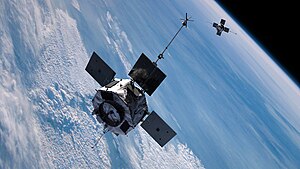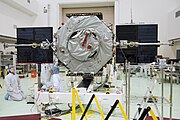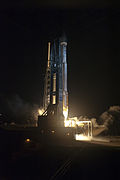Van Allen Probes
| Van Allen Probes | |
|---|---|
 | |
| Land: | |
| Betreiber: | |
| COSPAR-ID: | 2012-046A, 2012-046B |
| Missionsdaten | |
| Masse: | Sonde A: 648 kg Sonde B: 667 kg |
| Start: | 30. August 2012, 08:05 UTC |
| Startplatz: | Space Launch Complex 41, Cape Canaveral |
| Trägerrakete: | Atlas V (401) |
| Betriebsdauer: | 7 Jahre |
| Status: | abgeschaltet |
| Bahndaten | |
| Bahnneigung: | 10° |
Die Van Allen Probes, vormals Radiation Belt Storm Probes (RBSP, Strahlungsgürtel-Sturmsonden), sind zwei inaktive Raumsonden der NASA zur Untersuchung des Van-Allen-Strahlungsgürtels, der die Erde umgibt. Die Mission gehörte zum NASA-Programm „Living With a Star“.[1] Die Ergebnisse der Sonden sollten zum Verständnis der Umgebung und der Veränderlichkeit des Strahlungsgürtels beitragen. Dies ist für den Betrieb und den Entwurf von Weltraummissionen, die Missionsplanung und die Sicherheit der Raumfahrer sehr wichtig.[2]
Allgemeines

Das Goddard Space Flight Center ist für das Programm Living With a Star verantwortlich, dessen Teil Van Allen Probes zusammen mit dem Solar Dynamics Observatory (SDO) waren. Das Applied Physics Laboratory (APL) an der Johns Hopkins University trug die Verantwortung für die gesamte Implementierung und das Gerätemanagement. Die primäre Mission war für eine Dauer von 2 Jahren geplant, mit einer möglichen Verlängerung von bis zu 4 Jahren. Die Sonden sollten mit dem Balloon Array for RBSP Relativistic Electron Losses (BARREL) zusammenwirken, welches die Teilchen maß, die aus dem Strahlungsgürtel bis zur Erde gelangten.[3][4]
Meilensteine
- Fertigstellung des Konzepts der Mission, 30. Januar 2007[5]
- Bestätigung des vorläufigen Entwurfs, Oktober 2008
- Bestätigung des endgültigen Entwurfs, Januar 2009
- Transport der Sonden vom APL in Laurel, Maryland zur Cape Canaveral Air Force Station in Florida, 30. April 2012
- Start der Atlas V-401-Trägerrakete am 30. August 2012 um 8:05 UTC vom Cape Canaveral AFS Launch Complex 41.[6]
- Umbenennung der Radiation Belt Storm Probes in Van Allen Probes am 9. November 2012.[7]
- Missionsende der Sonde B am 19. Juli 2019[8]
- Missionsende der Sonde A am 18. Oktober 2019.[9]
- Test der Solarpaneele an der Van Allen Probe A
- Van Allen Probe A (oben) und B (unten) auf ihrem Adapter
- Start der Atlas V mit den Van Allen Probes an Bord
Start
Am 16. März gab die United Launch Alliance (ULA) bekannt, dass sie von der NASA den Auftrag zum Start der Van Allen Probes mit einer Atlas-V-401-Trägerrakete erhalten hat.[10] Der Start erfolgte am 30. August 2012 8:05 Uhr UTC innerhalb des vorgesehenen, 20-minütigen Startfensters.[6][11]
Ergebnisse
Die Satelliten entdeckten, dass sich durch einen besonders kräftigen Sonnenwindstoß ein weiterer (dritter) Strahlungsgürtel um die Erde bilden kann.[12] Dieser bildet sich außerhalb des bisherigen äußeren Ringes. Der bisher äußere Ring wird dafür ein Speicher für hochenergetische Teilchen.[12] Diese Konfiguration ist dann stabil, bis ein weiterer Sonnenwindstoß die ursprüngliche Konfiguration wieder entstehen lässt. Ob das öfters passiert, ist noch unbekannt.[12][13]
Siehe auch
Weblinks
- Hi-res spherical panoramas in the clean room before encapsulation for launch
- Van Allen Probes - Missionsübersicht (englisch)
- NASA Radiation Belt Storm Probes Press Kit August 2012 (PDF; 873 kB)
Quellen
- ↑ Van Allen Probes - Mission Overview. NASA, 28. März 2012, abgerufen am 8. Juli 2012.
- ↑ Radiation Belt Storm Probes (RBSP) (Memento vom 2. Mai 2012 im Internet Archive)
- ↑ Karen C. Fox: Launching Balloons in Antarctica. NASA, 22. Februar 2011, abgerufen am 13. Juli 2012.
- ↑ Balloon Array for RBSP Relativistic Electron Losses
- ↑ Construction Begins! The Johns Hopkins University Applied Physics Laboratory, Januar 2010, archiviert vom am 24. Juli 2012; abgerufen am 30. August 2012.
- ↑ a b RBSP Launch. NASA, abgerufen am 30. August 2012.
- ↑ NASA Renames Radiation Belt Mission to Honor Pioneering Scientist
- ↑ First of Two Van Allen Probes Spacecraft Ceases Operations. NASA, 23. Juli 2019.
- ↑ NASA’s resilient Van Allen Probes shut down. Spaceflight Now, 20. Oktober 2019.
- ↑ United Launch Alliance Atlas V Awarded Four NASA Rocket Launch Missions. ULA, 16. März 2009, abgerufen am 30. August 2012.
- ↑ Radiation Belt Storm Probes arrive at Florida launch site. Spaceflight Now, 2. Mai 2012, abgerufen am 30. August 2012.
- ↑ a b c Tilmann Althaus: Irdische Magnetosphäre, Manchmal hat das Erdmagnetfeld drei Strahlungsgürtel, in Sterne-und-Weltraum.de, 28. Februar 2013, abgerufen am 3. März 2012
- ↑ Van-Allen-Probes-Mission: Nasa-Sonden finden Strahlungsgürtel der Erde. Spiegel Online, 1. März 2013, abgerufen am 3. März 2013.
Auf dieser Seite verwendete Medien
The identical Radiation Belt Storm Probes will follow similar orbits that will take them through both the inner and outer radiation belts. The highly elliptical orbits range from a minimum altitude of approximately 373 miles (600 kilometers) to a maximum altitude of approximately 23,000 miles (37,000 kilometers).
CAPE CANAVERAL, Fla. - Inside the Astrotech payload processing facility near NASA’s Kennedy Space Center in Florida, technicians deploy the solar arrays and magnetometer boom of the Radiation Belt Storm Probes, or RBSP, spacecraft A. Deploying these components are standard procedure to ensure they work properly on Earth before they head into space. NASA’s RBSP mission will help us understand the sun’s influence on Earth and near-Earth space by studying the Earth’s radiation belts on various scales of space and time. As the spacecraft orbits Earth, the four solar panels will continuously face the sun to provide constant power to its instruments. The boom will provide data of the electric fields that energize radiation particles and modify the structure of the inner magnetosphere. RBSP will begin its mission of exploration of Earth’s Van Allen radiation belts and the extremes of space weather after its launch aboard a United Launch Alliance Atlas V rocket. Launch is targeted for Aug. 23. For more information, visit http://www.nasa.gov/rbsp.
CAPE CANAVERAL, Fla. – The United Launch Alliance Atlas V rocket carrying NASA's Radiation Belt Storm Probes, or RBSP, lifts off Space Launch Complex 41 on Cape Canaveral Air Force Station in Florida at 4:05 a.m. EDT. RBSP will explore changes in Earth's space environment caused by the sun -- known as "space weather" -- that can disable satellites, create power-grid failures and disrupt GPS service. The mission also will provide data on the fundamental radiation and particle acceleration processes throughout the universe. For more information on RBSP, visit http://www.nasa.gov/rbsp.
RBSP science overview.
TITUSVILLE, Fla. - Inside the Astrotech payload processing facility in Titusville, Fla. near NASA’s Kennedy Space Center, technicians checkout the two Radiation Belt Storm Probes, or RBSP, spacecraft prior to vertical encapsulation in the payload faring. The fairing will house and protect the RBSP during liftoff and flight through the atmosphere aboard an Atlas V rocket. NASA’s RBSP mission will help us understand the sun’s influence on Earth and near-Earth space by studying the Earth’s radiation belts on various scales of space and time. RBSP will begin its mission of exploration of Earth’s Van Allen radiation belts and the extremes of space weather after its liftoff aboard a United Launch Alliance Atlas V from Space Launch Complex 41 at Cape Canaveral Air Force Station, Fla. Liftoff is targeted for Aug. 23, 2012. For more information, visit http://www.nasa.gov/rbsp.
Radiation Belt Storm Probe (RBSP) drawing










